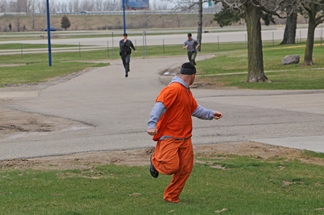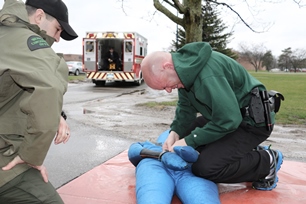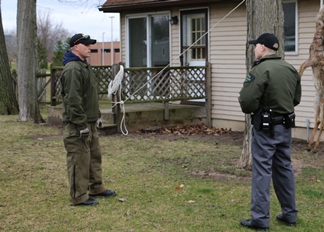Fighting through the pain
Week 13: March 27 to April 2
All 19 conservation officer recruits returned Sunday evening, ready to tackle the week ahead. This included fighting through the pain of OC/CS gas (pepper spray).
They began the week on the Michigan State Police (MSP) indoor firing range, where the recruits completed qualifications with their Sig Sauer .40-caliber handguns. All recruits qualified.
Investigations
Monday morning, MSP Trooper Raymond Hoffman instructed the recruits on child abuse and neglect investigation. Knowing that the safety of the child is paramount, recruits learned about their responsibility to report cases of suspected child abuse and neglect to the Michigan Department of Health and Human Services. They also learned how to investigate the scene, interview parents and children and collect information and evidence.
Following this training, Trooper Hoffman instructed the recruits on sexual assault investigation. The instruction focused on responding to complaints of sexual assault, determining who was involved, providing medical care – such as taking the victim to the hospital – and turning all evidence over to specialized authorities.
Interrogation
Monday concluded with interrogation procedures, taught by Conservation Officer (CO) Jeff Goss, recruit school staff. Recruits learned the difference between interviewing and interrogation, as well as the unique methods of interrogation.
“All people are not interviewed or interrogated in the same way,” said Sgt. Jason Wicklund, recruit school commander. “People have different social, educational and criminal backgrounds and unique personalities. We have to take into consideration multiple facets when doing an interview and interrogation to ultimately convince them to trust us and tell the truth.”
Interviewing, Wicklund explained, has a primary purpose of gathering information. Interrogating, on the other hand, involves determining whether a suspect was involved. Interrogations often lead to confessions.
During this training, the recruits viewed and analyzed multiple video clips. They analyzed body language, mannerisms and other subtle cues to determine if the subject was telling the truth or being deceitful.
Conservation officers often utilize their interrogation skills when questioning suspected poachers, as well as persons involved in lesser crimes such as litter complaints or land use violations.
Early morning march
Recruits were up bright and early Tuesday. At 4 a.m., recruits – in uniforms, boots, duty belts and with weighted backpacks – began a 7-mile formation march, led by 1st Lt. Steven Burton of the DNR.
“The job of a conservation officer requires long walks, sometimes five or more miles one way, to access remote lakes, rivers, campgrounds and other locations where inspection and assistance is required or requested,” Sgt. Wicklund said.
Touring a jail
Following their march, the recruits traveled to the Eaton County Jail to observe the inmate booking process, tour the facility and gain a general understanding of what’s expected of them when bringing in a suspect. This included understanding jail protocol and completing appropriate forms.
 “The jail is an intimidating experience for any officer the first time they bring in someone,” Sgt. Wicklund said. “We want our recruits to have the knowledge and experience so that the first time they bring someone to jail they have an idea of what to do and how to do it.” “The jail is an intimidating experience for any officer the first time they bring in someone,” Sgt. Wicklund said. “We want our recruits to have the knowledge and experience so that the first time they bring someone to jail they have an idea of what to do and how to do it.”
Court proceedings
Afterward, they traveled to the Eaton County Court. Several weeks prior, the recruits, during a training scenario and under the close guidance and supervision of conservation officers, had investigated a mock deer poaching case. As part of this, they’d collected and documented evidence and wrote a report. Recruit school staff had selected the best report and presented the report to the prosecuting attorney for review. The recruit who’d authored the report took the stand to testify during the court proceeding. The rest of the recruit school sat in the juror area to observe.
“It was a good learning experience for all involved,” Sgt. Wicklund said. “Recruits saw firsthand why detailed reports are extremely important for a conviction. Defense attorneys spend considerable time reviewing police reports, and if it can be easily picked apart, it will be. The reports should be accurate, concise and leave absolutely no doubt that a crime was committed and the suspect committed the crime.”
Vehicle extractions scenario
That afternoon, recruits were back at the MSP training facility for survival tactics training in the gymnasium, this time focusing on vehicle extractions. The recruits learned and practiced removing an unwilling suspect from a vehicle.
The law
Laws on suspect identification, taught by retired Michigan State Police Inspector David Greydanus, kicked off Wednesday morning. This involved suspect identification in different types of lineups. Juvenile law, also taught by Inspector Greydanus, followed. The differences between laws and standards applying to juveniles and adults were outlined.
 “Juveniles are treated differently from adults,” Sgt. Wicklund said. “Officers need to follow particular guidelines for questioning, detaining and petitioning juveniles who have committed or been suspected of crimes.” “Juveniles are treated differently from adults,” Sgt. Wicklund said. “Officers need to follow particular guidelines for questioning, detaining and petitioning juveniles who have committed or been suspected of crimes.”
Challenging scenarios
That afternoon, recruits moved to the gym where they completed several scenarios. The first involved an escaped prisoner. Recruits received a BOL (be on the lookout) for an escaped prisoner and were told the prisoner was last seen wearing an orange prison jumpsuit. Recruits then were accompanied outside by training staff to begin the scenario. Once outdoors, the recruits each saw a man walking on the sidewalk wearing an orange jumpsuit who, upon being noticed, ran away from the recruit. The goal was to safely pursue and apprehend the prisoner, utilizing tactical and situational awareness.
“Recruits used their training and experience from the last several weeks to successfully complete this exercise,” Sgt. Wicklund said. “When the prisoner rounded the corner of the building, all recruits cut the corner wide, which enabled them to see that the prisoner had ducked behind the building and was wielding a knife. Had they not cut the corner wide, they would have run directly into the prisoner, and in a real-life situation that could have resulted in injury or death to the officer.”
 During the second scenario, recruits, in groups of two, were charged with clearing a building after a simulated commercial burglar alarm had sounded. They entered the dark building with flashlights on and guns drawn. The recruits found an intruder hiding in the building. Working as a team, the pair ordered the suspect to the ground and one recruit handcuffed him while the other recruit covered for his or her partner. During the second scenario, recruits, in groups of two, were charged with clearing a building after a simulated commercial burglar alarm had sounded. They entered the dark building with flashlights on and guns drawn. The recruits found an intruder hiding in the building. Working as a team, the pair ordered the suspect to the ground and one recruit handcuffed him while the other recruit covered for his or her partner.
Fighting through the pain
Thursday was not well anticipated. Whether it’s called OC spray, CS gas or pepper spray, it still has the same effect.
“It’s important that the recruits understand and feel the effects of OC spay and realize that they can fight through it and still be effective,” Sgt. Wicklund said.
After being sprayed in the eyes, recruits fought to cope. The feeling is similar to getting cayenne pepper in your eyes. It causes the mucus membranes in the nose and eyes to swell, limiting breathing and sight.
 During this training, recruits were expected to punch and kick the “blue man” – the blue, human-sized mannequin – and then handcuff it. All the while, they fought through the pain and limited breathing. During this training, recruits were expected to punch and kick the “blue man” – the blue, human-sized mannequin – and then handcuff it. All the while, they fought through the pain and limited breathing.
Medics and an ambulance were on scene to ensure safety for all recruits, who recovered without medical assistance after the exercise.
“This is a self-coping exercise. Recruits learn that they can get through an exposure, which builds confidence and technique,” Sgt. Wicklund said. “If they are ever sprayed with this during their careers, they will not experience the initial shock because they now know what to expect. The moment of paralyzing fear happens today – not when they’re lives depend on it.”
Traffic stop scenario
Fully recovered, recruits headed back outside for a Thursday evening traffic stop training scenario. In pairs, the recruits stopped a vehicle for a traffic violation. After contacting the occupants of the vehicle, the recruits discovered that the passenger in the vehicle had an active warrant for his arrest.
 Recruits worked together to remove the unwilling suspect from the vehicle, place him in handcuffs and search him – all the while keeping a close eye on the driver. Recruits worked together to remove the unwilling suspect from the vehicle, place him in handcuffs and search him – all the while keeping a close eye on the driver.
Poaching scenario
Friday morning, at the Michigan State Police scenario house – located next to the MSP training facility – recruits completed their final scenario for the week, this time pertaining to poaching. They received a complaint of an untagged deer hanging behind a residence. One at a time, recruits arrived to investigate. They also used their interrogation skills learned earlier in the week.
“In this scenario, the angry homeowner asked the recruit to leave,” Sgt. Wicklund said. “The recruit needed to articulate why he or she was there, why they were not leaving, and the violation.”
If any of the recruits gave the suspect an opportunity to assault them, the suspect (played by a conservation officer) did so. The recruit then had to take appropriate action and deal with subsequent results. This graded exercise garnered a pass or fail.
 “There are many ways to diffuse the situation and calm the suspect. Some recruits employed what they were taught and some recruits learned what happened when they did not,” Sgt. Wicklund said. “This scenario simulated a high-risk, highly volatile situation during which recruits were exposed to multiple situations with variable results. It was a good learning opportunity.” “There are many ways to diffuse the situation and calm the suspect. Some recruits employed what they were taught and some recruits learned what happened when they did not,” Sgt. Wicklund said. “This scenario simulated a high-risk, highly volatile situation during which recruits were exposed to multiple situations with variable results. It was a good learning opportunity.”
After lunch, recruits reviewed the scenario and their actions during it, going over ideal ways to handle each portion of the situation. They were then released for the weekend.
Subscribe to the weekly conservation officer academy blog, which also is posted weekly on the Michigan DNR Facebook page. View past blogs from Recruit School No. 7.
/Photo details: Accompanying photos are available below for download. Caption information follows.
Mock trial.jpg: Recruits took part in a mock poaching trail at Eaton County Court. A week prior, recruits had collected and documented evidence and written a report. Recruit school staff had selected the best report and presented the report to the prosecuting attorney for review. The recruit who authored the report took the stand to testify during the court proceeding.
Prisoner escape. jpg: During this training scenario, recruits each had the opportunity to safely pursue an “escaped prisoner” (played by a conservation officer). The goal was to safely pursue and apprehend the prisoner, utilizing tactical and situational awareness.
Pepper spray exercise.jpg: Recruits received OC spray/CS gas, also known as pepper spray, in their eyes during this self-coping exercise, meant to prepare them for real-life situations should this ever happen to them. After being sprayed, recruits were expected to punch and kick the “blue man” – the blue, human-sized mannequin – and then handcuff it.
Pepper spray group.jpg: After each recruit completed the exercise of handcuffing the “blue man” – the blue, human-sized mannequin – after being sprayed with pepper spray, they formed support lines as they waited for the effects of the pepper spray to wear off. Pepper spray, also known as OC spray or CS gas, causes the mucus membranes in the nose and eyes to swell, limiting breathing and sight.
Traffic stop.jpg: During the traffic stop training scenario, recruits observed a traffic violation and made a traffic stop. The two vehicle occupants were contacted and, after checking them through DNR dispatch, the recruits found that the passenger had a misdemeanor warrant for his arrest. Recruits informed the passenger of his warrant, asked him to step out of the vehicle, and arrested him.
Poaching case.jpg: This training scenario involved a complaint of an untagged deer hanging behind a residence (the nearby Michigan State Police training house). One at a time, recruits arrived to investigate, using their interrogation skills learned earlier in the week. (The deer used in the scenario was found dead alongside the road days prior, resulting from a deer-vehicle collision. After being tested at the DNR laboratory for disease, it was transported to the academy for use in the scenario.)/
The Michigan Department of Natural Resources is committed to the conservation, protection, management, use and enjoyment of the state’s natural and cultural resources for current and future generations. For more information, go to www.michigan.gov/dnr.
|

 “The jail is an intimidating experience for any officer the first time they bring in someone,” Sgt. Wicklund said. “We want our recruits to have the knowledge and experience so that the first time they bring someone to jail they have an idea of what to do and how to do it.”
“The jail is an intimidating experience for any officer the first time they bring in someone,” Sgt. Wicklund said. “We want our recruits to have the knowledge and experience so that the first time they bring someone to jail they have an idea of what to do and how to do it.” “Juveniles are treated differently from adults,” Sgt. Wicklund said. “Officers need to follow particular guidelines for questioning, detaining and petitioning juveniles who have committed or been suspected of crimes.”
“Juveniles are treated differently from adults,” Sgt. Wicklund said. “Officers need to follow particular guidelines for questioning, detaining and petitioning juveniles who have committed or been suspected of crimes.” During the second scenario, recruits, in groups of two, were charged with clearing a building after a simulated commercial burglar alarm had sounded. They entered the dark building with flashlights on and guns drawn. The recruits found an intruder hiding in the building. Working as a team, the pair ordered the suspect to the ground and one recruit handcuffed him while the other recruit covered for his or her partner.
During the second scenario, recruits, in groups of two, were charged with clearing a building after a simulated commercial burglar alarm had sounded. They entered the dark building with flashlights on and guns drawn. The recruits found an intruder hiding in the building. Working as a team, the pair ordered the suspect to the ground and one recruit handcuffed him while the other recruit covered for his or her partner. During this training, recruits were expected to punch and kick the “blue man” – the blue, human-sized mannequin – and then handcuff it. All the while, they fought through the pain and limited breathing.
During this training, recruits were expected to punch and kick the “blue man” – the blue, human-sized mannequin – and then handcuff it. All the while, they fought through the pain and limited breathing. Recruits worked together to remove the unwilling suspect from the vehicle, place him in handcuffs and search him – all the while keeping a close eye on the driver.
Recruits worked together to remove the unwilling suspect from the vehicle, place him in handcuffs and search him – all the while keeping a close eye on the driver. “There are many ways to diffuse the situation and calm the suspect. Some recruits employed what they were taught and some recruits learned what happened when they did not,” Sgt. Wicklund said. “This scenario simulated a high-risk, highly volatile situation during which recruits were exposed to multiple situations with variable results. It was a good learning opportunity.”
“There are many ways to diffuse the situation and calm the suspect. Some recruits employed what they were taught and some recruits learned what happened when they did not,” Sgt. Wicklund said. “This scenario simulated a high-risk, highly volatile situation during which recruits were exposed to multiple situations with variable results. It was a good learning opportunity.”




